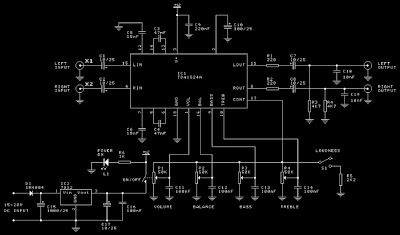loading...
This is hifi stereo pre-amp head with tone control circuit Using a special IC TDA1524A
All signal processing is done within the TDA1524A by voltage controlled amplifiers and voltage controlled filters. The IC provides a fixed voltage (~ 3.8V DC) at pin 17, and this is used by all the variable resistors to provide an adjustable DC voltage to the appropriate control pins.
Current sensing is used to provide a flat response when R5 is connected to pin 17, and a loudness contour when disconnected. 100 nF capacitors are used on each pot to decouple any AC signals from the control inputs. 10 uF capacitors are used to couple both input and output audio signals whilst blocking DC. R1 and R2, are to ensure stability with capacitive loads. R3 and R4 make sure there are no DC spikes at the output sockets if the load is switched. C3 and C4 control the loudness contour. C5 and C6 control the treble turn-over frequency. C18 and C19 have been added to roll off the gain above 70 kHz. Low volume settings coupled with treble boost was causing HF instability in some instances. This should no longer be a problem.
All signal processing is done within the TDA1524A by voltage controlled amplifiers and voltage controlled filters. The IC provides a fixed voltage (~ 3.8V DC) at pin 17, and this is used by all the variable resistors to provide an adjustable DC voltage to the appropriate control pins.
Current sensing is used to provide a flat response when R5 is connected to pin 17, and a loudness contour when disconnected. 100 nF capacitors are used on each pot to decouple any AC signals from the control inputs. 10 uF capacitors are used to couple both input and output audio signals whilst blocking DC. R1 and R2, are to ensure stability with capacitive loads. R3 and R4 make sure there are no DC spikes at the output sockets if the load is switched. C3 and C4 control the loudness contour. C5 and C6 control the treble turn-over frequency. C18 and C19 have been added to roll off the gain above 70 kHz. Low volume settings coupled with treble boost was causing HF instability in some instances. This should no longer be a problem.
C15, 16, 17 provide power supply filtering. D1 provides protection in case of incorrect supply polarity. The LED is a power on indicator and may be omitted if not required, or preferably mounted on the enclosure. If you are not using a switch pot, you can connect an external switch across the P1 switch pins, or connect a wire link there and switch the power supply.
The power supply is critical to the noise performance of the pre-amp head. An on board regulator is provided to reduce mains hum. If you wish to use it with a car or other 12V battery, then you should omit the 7812 regulator, and place a wire link between the regulator input and output pin positions on the PC board. Do not short to earth! This will be necessary because the regulator must have an input voltage at least 2-3V greater than it’s output, for it to maintain regulation. However the regulator will not be necessary with a battery supply.
If using a plug pack, it’s output voltage should be 15 to 18V DC. Because most plug packs have poor regulation, one rated at 12V DC will often be around 15V when lightly loaded. The current drain of the pre-amp is less than 50 mA, so many 12 V unregulated supplies may be adequate if you have one. Replace D1 with a wire link if necessary, making sure you have the supply polarity correct!
If you are using a 15-20V supply for your power amplifier, you can use that as your pre-amp supply as well. Make sure you test the voltage first in all cases.
The power supply is critical to the noise performance of the pre-amp head. An on board regulator is provided to reduce mains hum. If you wish to use it with a car or other 12V battery, then you should omit the 7812 regulator, and place a wire link between the regulator input and output pin positions on the PC board. Do not short to earth! This will be necessary because the regulator must have an input voltage at least 2-3V greater than it’s output, for it to maintain regulation. However the regulator will not be necessary with a battery supply.
If using a plug pack, it’s output voltage should be 15 to 18V DC. Because most plug packs have poor regulation, one rated at 12V DC will often be around 15V when lightly loaded. The current drain of the pre-amp is less than 50 mA, so many 12 V unregulated supplies may be adequate if you have one. Replace D1 with a wire link if necessary, making sure you have the supply polarity correct!
If you are using a 15-20V supply for your power amplifier, you can use that as your pre-amp supply as well. Make sure you test the voltage first in all cases.

0 Response to "Hifi stereo pre-amp head"
Post a Comment